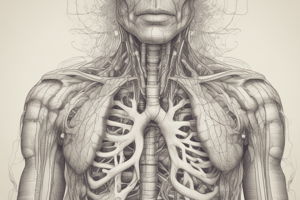Podcast
Questions and Answers
What is the primary function of the respiratory system?
What is the primary function of the respiratory system?
- Protection against infections
- Digestion of food
- Gas exchange between the blood and external environment (correct)
- Transportation of nutrients
Which part of the respiratory system is responsible for trapping dust and foreign particles?
Which part of the respiratory system is responsible for trapping dust and foreign particles?
- Pharynx
- Alveoli
- Nose (correct)
- Lungs
What are the three divisions of the pharynx?
What are the three divisions of the pharynx?
- Oropharynx, laryngopharynx, and epiglottis
- Nasopharynx, oropharynx, and laryngopharynx (correct)
- Superior, middle, and inferior conchae
- Nasal cavity, trachea, and bronchi
Which description best fits the function of the alveoli?
Which description best fits the function of the alveoli?
How does the nose aid in phonation?
How does the nose aid in phonation?
What mechanism do the nose and other respiratory structures use to prepare inhaled air?
What mechanism do the nose and other respiratory structures use to prepare inhaled air?
Which part of the respiratory system is NOT involved in gas exchange?
Which part of the respiratory system is NOT involved in gas exchange?
What role do cilia play in the respiratory system?
What role do cilia play in the respiratory system?
What is one of the primary functions of the larynx?
What is one of the primary functions of the larynx?
What role does the epiglottis play during swallowing?
What role does the epiglottis play during swallowing?
Which statement regarding vocal cords is accurate?
Which statement regarding vocal cords is accurate?
What connects the larynx to the main bronchi?
What connects the larynx to the main bronchi?
How are the bronchi structured in relation to the trachea?
How are the bronchi structured in relation to the trachea?
What is the main function of the ciliated mucosa in the trachea?
What is the main function of the ciliated mucosa in the trachea?
Why is the left bronchus smaller than the right bronchus?
Why is the left bronchus smaller than the right bronchus?
What distinguishes male and female vocal cords?
What distinguishes male and female vocal cords?
Study Notes
Objectives of the Respiratory System Study
- Identify different parts of the respiratory system.
- Explain functions and importance of each part.
- Show the transportation of gases to and from body parts.
Levels of Organization in the Body
- Cells - Basic unit of life.
- Tissues - Grouped into four types: epithelial, connective, muscular, and nervous.
- Organs - Structures such as stomach, liver, and heart.
- Organ Systems - Combinations of organs, e.g., respiratory, circulatory, and digestive systems.
Human Organ Systems
- Skeletal
- Muscular
- Circulatory
- Immune
- Respiratory
- Digestive
- Excretory
- Reproductive
- Nervous
- Endocrine
- Integumentary
Definition and Functions of the Respiratory System
- Respiration involves gas exchange between an organism and the environment.
- Gas exchanges occur primarily in the alveoli of the lungs.
- Passageways leading to the lungs purify, warm, and humidify incoming air.
- The respiratory system shares gas exchange responsibilities with the cardiovascular system.
Structures of the Respiratory System
-
Nose
- The nostrils, or anterior nares, serve as the entry point for air.
- Divided into three conchae: superior, middle, and inferior.
- Functions include:
- Air passageway.
- Warming and moistening inhaled air.
- Trapping dust and foreign matter via cilia and mucus.
- Housing olfactory receptors for smell.
- Aiding in phonation (voice quality).
-
Pharynx (Throat)
- A muscular, membranous tube about 5 inches long.
- Composed of three parts: nasopharynx, oropharynx, laryngopharynx.
- Functions include:
- Passageway for air and food.
- Assisting in voice modulation.
-
Larynx (Voice Box)
- Located at the upper end of the trachea; lined with mucous membrane.
- Contains the epiglottis (covers larynx during swallowing) and various cartilages:
- Thyroid cartilage (Adam's apple), larger in males.
- Cricoid cartilage houses vocal cords.
- Vocal cord tension produces different pitches (tense for high, relaxed for low).
-
Trachea (Windpipe)
- A smooth muscular tube connecting larynx to bronchi; about 4.5 inches long.
- Lined with ciliated mucosa; cilia expel mucus and debris away from lungs.
- Approximately 1 inch in diameter.
-
Bronchi
- Main branches from the trachea dividing into right and left bronchus.
- The left bronchus is smaller; foreign objects may lodge in the larger right bronchus.
- The bronchi further subdivide into bronchial tree structures.
-
Lungs
- Two spongy organs located within the thorax responsible for gas exchange.
Studying That Suits You
Use AI to generate personalized quizzes and flashcards to suit your learning preferences.
Description
Explore the objectives and functions of the respiratory system in this quiz. Learn about the different parts, their importance, and the gas exchange process. Test your knowledge on the levels of organization in the human body as well!




